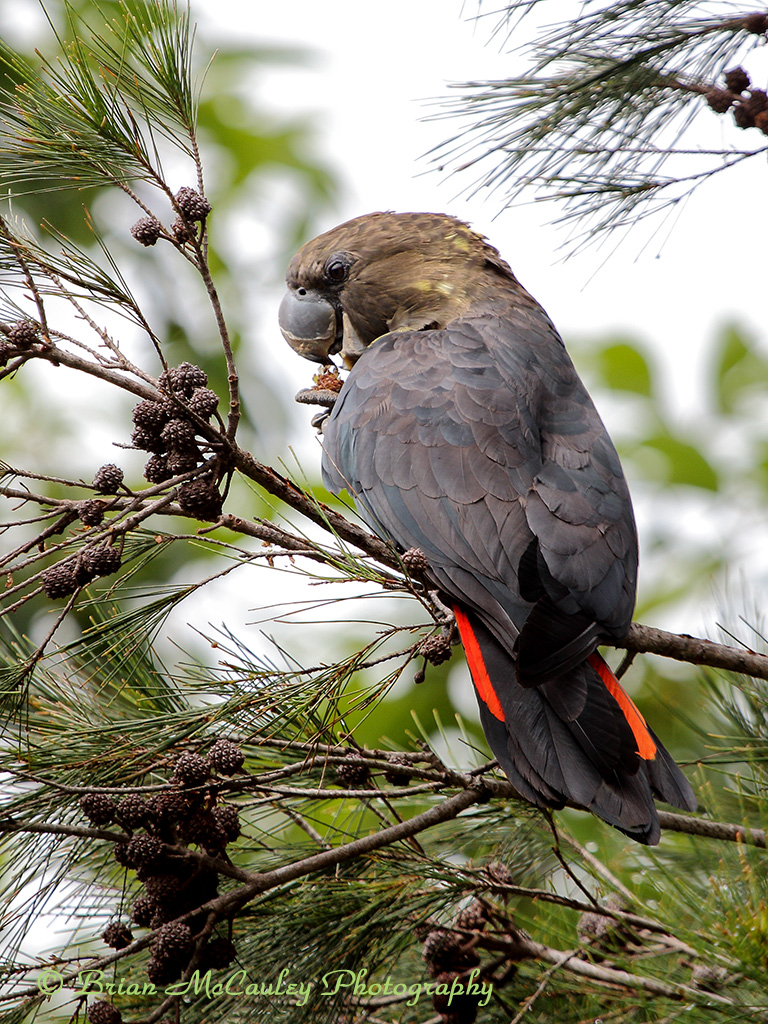Black-cockatoos are among Australians’ most beloved birds. Least familiar among them is the Glossy Black-Cockatoo, Calyptorhynchus lathami.
Glossies occur from south-eastern Queensland to Mallacoota, extending west to the Riverina and Narrabri in New South Wales. They have been recorded near Paluma in the Wet Tropics of far north Queensland.
An isolated population of several hundred Glossies lives on Kangaroo Island. They are likely to have been severely impacted by the Australian bushfires.
Glossies are almost completely confined to south-eastern Australia. They live in the part of the continent known biogeographically as the Bassian subregion or province. They are emblematic of the Bassian species that the current bushfire crisis will be severely impacting.

A highly specialised diet
Glossies are among the most diet-specialised birds in the world. They feed almost solely on the seeds of casuarina trees in the genus Allocasuarina, not the more familiar river casuarinas such as Casuarina cunninghamiana. Their primary food trees are the species A. verticillata (on Kangaroo Island and in the Riverina) and A. torulosa and A. littoralis (just about everywhere else).
Allocasuarina trees are dioecious, meaning that male and female trees are separate individual trees. The seeds that Glossies eat are produced only by female trees. The birds spend hours every day extracting the seeds from the closed valves of these cones. Allocasuarina trees have probably not taken this kind of predation without an evolutionary fight. It's not surprising that suitable female food trees are always patchily distributed.
Allocasuarina trees take ten years or more to produce cones and even longer to have branches thick enough to support the weight of a Glossy trying to feed. Intense bushfires can wipe out feeding habitat rather than leaving a mosaic of burned and unburned areas. This can have a truly devastating effect on the food supply of Glossies, both immediately and for years afterwards.
If bushfires had always been as intense as the current ones, we probably would not have Glossy Black-Cockatoos as we know them.
Glossy Black-Cockatoos on Kangaroo Island
On Kangaroo Island, Glossy strongholds are precisely the areas that have been burned on the north and west coasts of the island. If the birds survived the fires then their nearest unburned feeding areas may well be the less Allocasuarina-rich parts of the island’s eastern end. We just don’t know the details yet.
Glossies need tall eucalypts with suitably sized nest-hollows for breeding. On Kangaroo Island, these are principally Sugar Gums, Eucalyptus cladocalyx, and Blue Gums, E. leucoxylon. Such trees are prone to being felled in fires of this intensity. Like all black-cockatoos, the birds take several years to reach sexual maturity. They raise single nestlings.
This means that intense bushfires can have far more devastating effects on Glossies than we may at first think. This is due to the cascade of disrupted ecological interactions that severe bushfires can cause. It is simply too soon to know whether the Kangaroo Island Glossies will starve or what the eventual outcome will be. The population’s viability is likely to be hugely stressed.
The mainland population, while numerically larger and scattered in loosely connected subpopulations, will likely be suffering all the same consequences. Mallacoota is well known as a place to see Glossy Black-Cockatoos, as I was fortunate to do so last March when visiting the area.
As with so many species, we anxiously await the news that will filter through as it becomes safe to investigate burned areas and assess the real extent of these fires. We brace for tragic news.
Leo Joseph is Director of CSIRO’s Australian National Wildlife Collection and, with friends and colleagues, initiated study of Kangaroo Island’s Glossy Black-Cockatoos in 1979-80.
Find out about the impact on bushfires on Australian insects.
